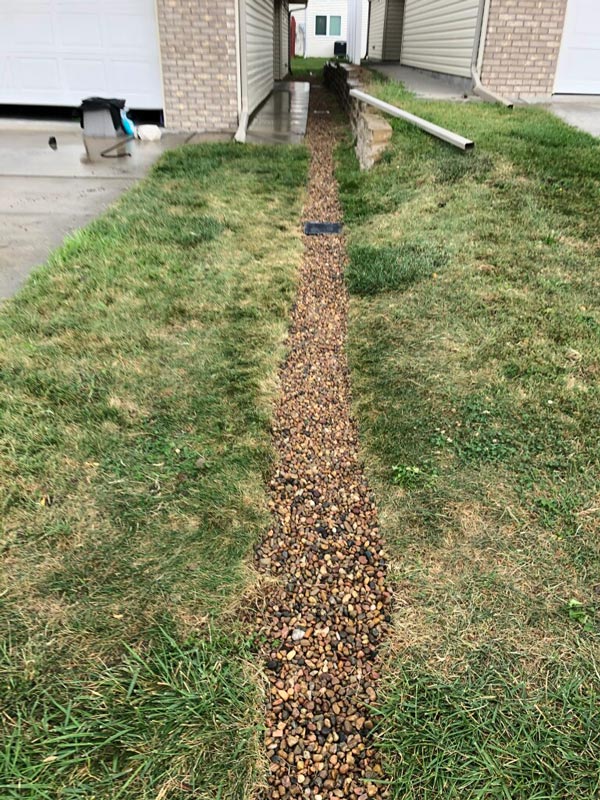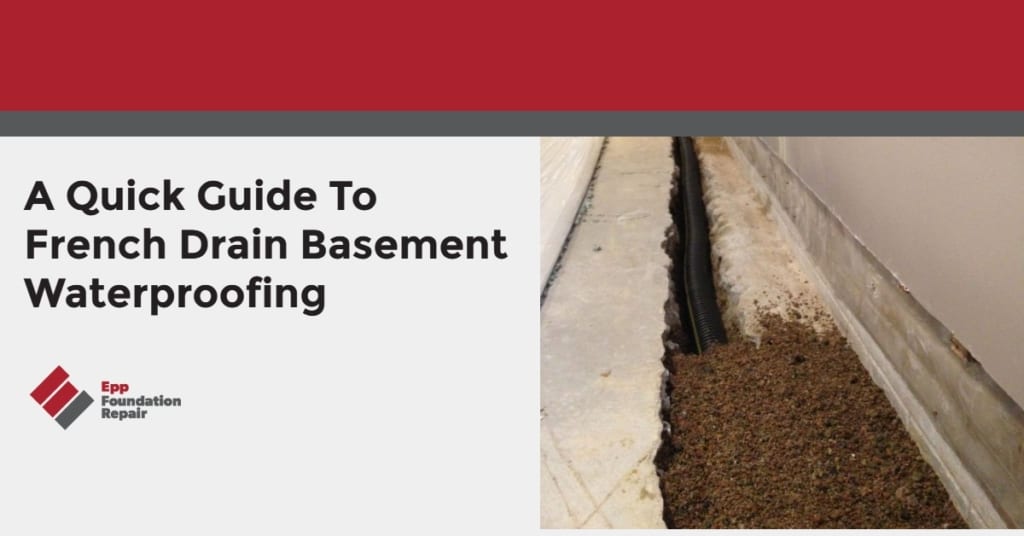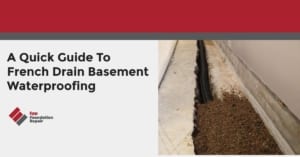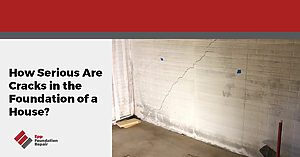French drains: A solution for your wet basement
French drains, a popular and very effective basement waterproofing system, keep basements dry by channeling water away from the foundation. Other names for French drains include drain tile, footing drain, foundation drain, curtain drain, weeping tile, perimeter drain, and sub-surface drain.
Oh, and a French drain has nothing to do with France. The name of the inventor was a 19th century American named Henry French.
What is a French drain system for a basement?
A French drain is a popular basement waterproofing solution that involves laying either perforated pipe or flexible corrugated pipe in a shallow trench along with gravel. The perforated pipe channels any excess water in the soil under and around your home’s foundation into a collection pit. From there, it’s channeled away from the foundation via gravity or by using a sump pump. (In just a bit we’ll describe how sump pump drainage works.)
A French drain can either be installed in your home’s interior, under the basement floor, or outside the home, buried in the soil along the foundation footing. Both are very effective solutions for a wet basement.
French drains don’t prevent water from getting into your basement. Instead, they take water under and around your home and channel it away from the foundation before it has a chance to find its way inside. Depending on how you plan to use your basement, the trench with the perforated pipe might be covered with concrete, a grate, or not at all.
Installing a French drain in an existing house is a major construction project. If it’s installed inside, under the basement floor, it will mean using a jackhammer to dig up the floor for the trench. If the French drain is installed outside, along the foundation’s perimeter, it will mean heavy excavation down to the footer. Therefore, we don’t recommend it as a DIY project.
French drains relieve hydrostatic pressure
French drains relieve hydrostatic pressure against your foundation wall or floor by making sure the soil under and around your foundation never gets over-saturated with water.
If you’re thinking about installing a French drain in your basement, you probably already know that there’s more to keeping a basement dry than just sealing cracks and plugging holes. In other words, water getting into your basement is just part of the problem. There’s also the problem of hydrostatic pressure. Here’s how that works:
When water builds up in the soil outside your basement walls or under the basement floor and doesn’t have a way to drain off, hydrostatic pressure will build up and push against the walls and/or the floor. If this goes on long enough, the walls will start to bow inward and may even crack. Hydrostatic pressure can even force water through a basement wall or floor. Therefore, a good drainage system not only keeps your basement dry it also preserves your home’s structural integrity by preventing hydrostatic pressure from building up in the first place.
Because basements are below grade (i.e., underground), they’re more susceptible to water intrusion, which can damage valuables and create an unhealthy, mold-filled environment. Today, almost all new homes are built with a drain tile system. However, older homes built before the latest building codes often don’t have foundation drainage systems and are therefore at risk of water intrusion.
Check out more about: Difference Between Structural and Non-Structural Foundation Cracks
French drains can be installed inside or outside your home
A French drain installed either inside, under your basement floor, or outside, buried along the foundation footer, prevents hydrostatic pressure from building up by making sure the soil never gets saturated. All excess water is channeled away from the foundation, either via gravity or by using a sump pump. (Note that a French drain is not the same as a channel drain. Channel drains are above ground drainage systems.)
How does sump pump drainage work?
An electric sump pump takes the water in the collection pit and pumps it to the surface, away from the foundation.
There are two types of sump pumps: submersible and pedestal.
Submersible sump pumps go into the collection pit under the basement floor. Once the water in the pit reaches a certain level, the pump kicks in and gets rid of it. The smaller the collection pit, the more frequently the pump has to work.
Pedestal sump pumps sit on a pole above the collection pit and have a float like a toilet tank. When the water in the pit rises, so does the float. When the float rises to a certain point, the pump kicks in and directs the water to the surface.
How much does it cost to install a French drain in a basement?
The cost to install a French drain in the basement of an existing home depends on various factors, including your geographical location, the size of the drain, and whether you DIY (not recommended) or hire a contractor. Therefore, we can’t give you even a ballpark figure.
The only way to know the cost of installing a basement French drain system is to contact a professional foundation repair contractor for an inspection and estimate. Most contractors will do the assessment for free and will be able to tell you if a French drain is a solution that will work for you.
What’s the difference between a basement floor drain and a basement French drain?
A French drain gets rid of the water in the soil under and around your foundation before it has a chance to make its way into your basement. In contrast, a basement floor drain gets rid of water that might, for example, spill out of your washing machine or laundry sink. This is why basement floors are sloped slightly. If your laundry machine overflows, the water flows down the basement floor drain and into either the sewer or into a collection pit where a sump pump then gets rid of it.
The Advantages of Installing a French Drain
- Reduces risk of flooded basements and crawl spaces – A French drain helps to reduce the risk of basement or crawl space flooding, thereby preventing water damage and expensive repairs. This is especially important for properties situated in areas that experience heavy rainfall or are in a flood zone.
- Helps prevent hydrostatic pressure – By removing excess water from the soil surrounding a building, a French drain can help stabilize the soil and prevent foundation settlement. This helps lower the risk of structural damage to buildings and foundations.
When to Consider Installing a French Drain
Some signs that may indicate the need for a French drain include the following:

- Persistent dampness or standing water in your basement or crawl space – If you frequently find puddles of water or notice a musty smell in your basement or crawl space, it could be a sign of poor drainage around the foundation.
- Cracked or leaky foundation walls – Cracks or leaks in your basement or crawl space walls could indicate hydrostatic pressure has built up in the soil and is pushing against the foundation.
- Mold or mildew growth – The presence of mold and mildew in your basement is a sign that moisture is present and not being properly drained away. Installing a French drain can help alleviate this issue.
- Flooding during heavy rain – If your property is prone to flooding during heavy rain, it may be a sign you need a French drain.
Is installing a French drain in a basement a DIY project?
We don’t recommend that you install a French drain in a basement by yourself. It’s a major construction project that will involve using a jackhammer to break up your basement floor (i.e., your home’s foundation). If you don’t do it properly, you could cause considerable damage, and then you’ll need to hire a professional to come in and fix everything. If that happens, you’ll end up paying twice. Once, for the materials (and the time you spend working on the project), and then again for the professional contractor to do the French drain installation (and repair any damage).
Avoid costly french drain mistakes with this helpful guide. Learn how to properly install a French drain system, the materials needed, and how to maintain your system. Get the knowledge you need to ensure a successful installation.
Don’t take any chances. Contact a professional foundation repair contractor for an inspection and French drain estimate. Most of them will do the assessment for free.
Read also: Droughts and Your Foundation
What about exterior French drain basement waterproofing?
An exterior French drain along your foundation’s footing is another basement waterproofing solution. However, installing an exterior French drain in an existing home is more involved than installing a French drain in the basement of an existing home. This is because installing an exterior French drain requires heavy excavation to expose the foundation wall(s) down to the footing. Once that’s done, the contractor applies a waterproofing product to the basement wall, followed by a drainage board. Finally, a trench is dug along the footing, and then the perforated pipe is placed in it and covered with gravel. The final step involves replacing the excavated soil.
If your property has a slope, gravity will move the water away from the foundation. If not, you’ll need a collection pit and a sump pump.
Like a basement French drain installation, an exterior French drain works to prevent hydrostatic pressure caused by water-saturated soil. Today, most new homes with basements are built with both an interior and an exterior French drain basement waterproofing system.
Other ways to keep water from entering your basement
Since water causes most foundation problems, homeowners should ensure the soil under and around their home’s foundation doesn’t get over-saturated with water.
- Don’t plant water-hungry shrubs and flowers next to the foundation. When you water them, the soil gets soaked, and then if there are drainage problems, the water could find a way into your basement.
- Make sure your yard slopes away from your home. If it doesn’t, you might need to get it regraded.
- Check to see if your gutters are working correctly. Clogged gutters can cause water to overflow and run down the side of your home and into the soil next to the foundation. Therefore, make sure you clean your gutters regularly.
- Downspouts that are too short can dump water into the soil next to your foundation. Downspout extensions will ensure that rainwater gets channeled away from the foundation.
While a French drain basement waterproofing solution is more expensive than other waterproofing methods, it’s highly effective. In fact, it may be the most effective basement waterproofing method around because it doesn’t just stop water from getting in; it channels water away from the foundation.
We serve Lincoln, Omaha, Grand Island, Kearney, NE and more with basement waterproofing services. Call us to schedule an inspection and receive an estimate based on your needs.







